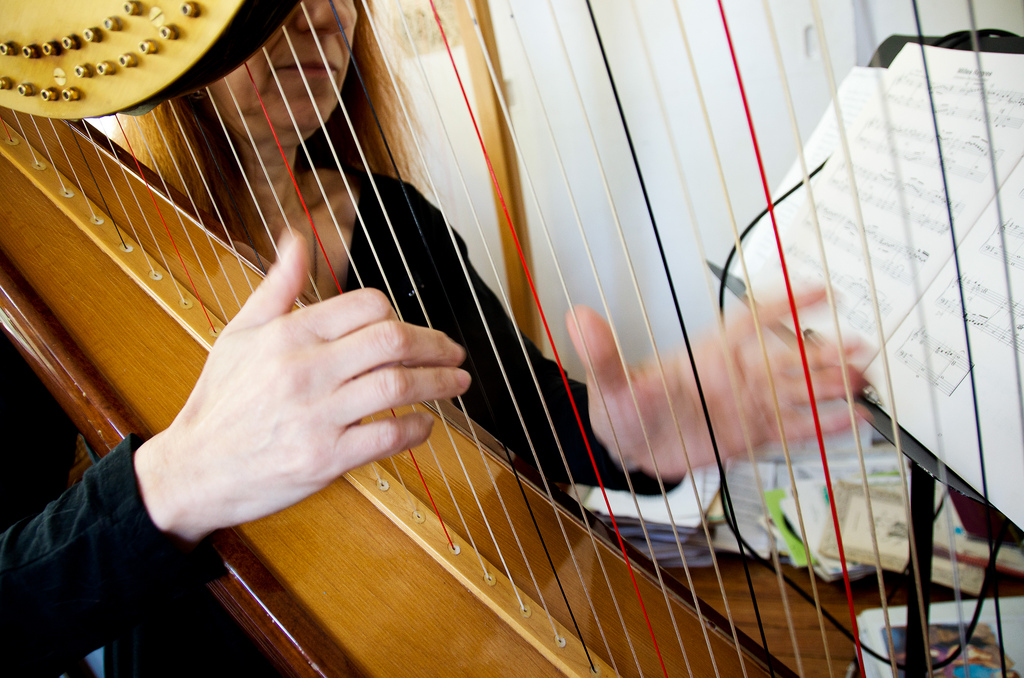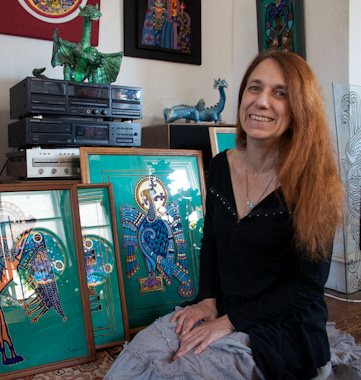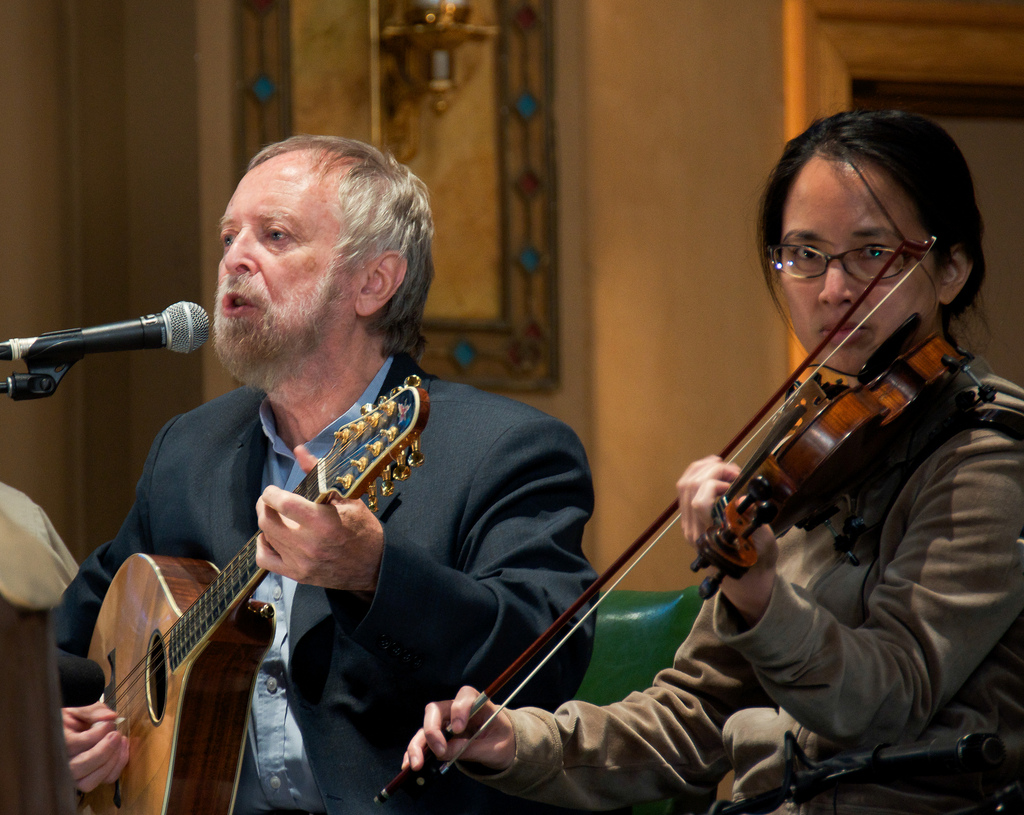Ellen Formanek Tepper’s little house in Ardsley looks like it’s been invaded by The Book of Kells.
It’s her artwork, minutiae from the illuminated Gospels created by 9th century Irish monks, painted on glass, which she is gathering to transport for a show at the Community Music School in Trappe, starting on November 9. It’s called Celtic Refractions, and she is still trying to come up with an artist’s description. “I call it taking minutiae and make them huge and bringing light to the Dark Ages,” says Tepper, who is probably equally well known for her work as a harpist and harp instructor as she is for her colorful translucent glass paintings.
Though she’s not Irish, she claims affinity. “I’m a proto-Celt,” she jokes. “My family came from the Rhine Valley and the Danube Valley where the Celts started before they came to Ireland.”
A native New Yorker, Tepper spent her formative years in Vienna, Austria, where her father was principal of the American International School. “We were school-homed,” she says, revealing the sense of humor she’s also known for, both onstage and off.
Her German-born mother, whose Jewish family fled Germany, was a psychologist and professor of education who loved museums, so she “dragged us [Ellen, her brother and sister] reading history along the way” on their extended vacations in Europe. Tepper not only absorbed the history, she assimilated the art, particularly the medieval works that now appear in her own creations. At school, she learned to speak German, to draw, dance, and play the harp.
“My father taught me how to embroider, which he learned from watching his mother,” she says. “When I was ready to go to college I didn’t know whether to go to music school or to art school.”
She went to Philadelphia College of Art—now the University of the Arts—but majored in music. She thought she could do both, but the music courses were so demanding “it was just too much work,” she recalls. But when she finally graduated, “the art just burst out.” She sat down and sketched an intricate and detailed embroidery pattern for a 14th Century Venetian harp she saw on a poster and started sewing. The embroidery won a national prize and, though it’s for sale, now hangs on a wall in her living room.
Sewing was her métier for many years as she raised three children, most of the time as a single mother. “When the kids were little I sewed a lot for them and I made pin money making these quilted vests.” She pulls several out of a plastic bag, tiny vests with rainbows and other toddler-friendly designs, some of which now fit her granddaughter. “I would make art during naptime then I would see my work running around,” she laughs.
Tepper’s glass art came much later, the result of the doodling she does to keep her hands busy when she’s not using them for the harp or other things. “I was doing spiral drawing on blank puzzles at The Shanachie [the now defunct Irish pub in Ambler] while sitting at the bar, listening to other people play music,” she recalls. “Then I started putting them on glass. It was all inspired by the bartender at the Shanachie who was also an artist and who I used to tip with art materials. One day he said that he had a friend who had just started painting on glass.”
She discovered oil-based markers and found herself gravitating toward the Book of Kells, with its intricate and ornate pages that marry Latin religious text with Celtic symbolism. And believe it or not, she takes her designs not directly from the book, but from coloring books, which both magnify and simplify the images. She copies, alters them the way she wants them, and enlarges them. Then she tapes her drawing face down on the front of the glass she’s using—often a discarded window—and traces it from the back, where she also colors it.
And no, it’s not cheating. “When I was in the Embroiderer’s Guild, this was known as ‘original adaptation,’” she explains.
Her pieces range from convoluted Celtic knotwork to figures like the Gospel writers and St. Brendan the Navigator on his ship heading for the “island of the blessed.”
What won’t be on display at her show, which runs through January 5, will be her dragons which she cooks up—literally—in her kitchen. They’re an outgrowth of the dolls she used to make, tiny sculptures of fairies, 14th century composers, and rock musicians she did for fun. The dragons—Tepper calls them her “lounge lizards”—are made from polymer clay which she rolls out of a pasta machine into sheets and cuts into gills, which she layers on a frame made from a coat hanger, aluminum foil, and 16-gauge florist wire, “like shingles on a roof.”
“I also have a dedicated garlic press that I used to make some parts,” she says. “These cooking utensils should never be used for food again.”
Once the lizard is the way she wants it, she bakes it in her oven, using empty cat food cans (she has two cats) to protect its limbs from the heating element.
When she’s not making art, Tepper is making music. A harp teacher, she’s also a popular gig artist. With singer-musician Terry Kane, she’s the other half of the Jameson Sisters. The two combine harp, mandolin, and guitar with vocals in both English and Irish, but they also do Baroque and early music, show tunes, and Christmas music. They’re usually at Molly Maguire’s Restaurant and Pub in Phoenixville every fourth Sunday of the month where they lead the session. Tepper also appears solo and does several programs on the history of the harp and of Christmas carols, accompanied by what she calls her “Tepper schlepper,”—whoever she can cajole into carrying her large pedal harp. She’ll be doing that program on November 29 at Glen Foerd Mansion on the Delaware, 5001 Grant avenue in Philadelphia, starting at 7 PM.
And when she lifts the harp off her shoulder, watch her pick up her sketchbook. “I know, I know,” she says with a grin. “I’m prolific. And I can’t stop myself.”
“Celtic Refractions” will be on display at The Gallery at Community Music School, 775 W. Main Street, Trappe, PA, from November 9 to January 5. You can also see Tepper’s work at the Water Gallery in Lansdale, 319 West Main Street in the Dresher Arcade.
Visit with Ellen Tepper and her art via our photo essay.



